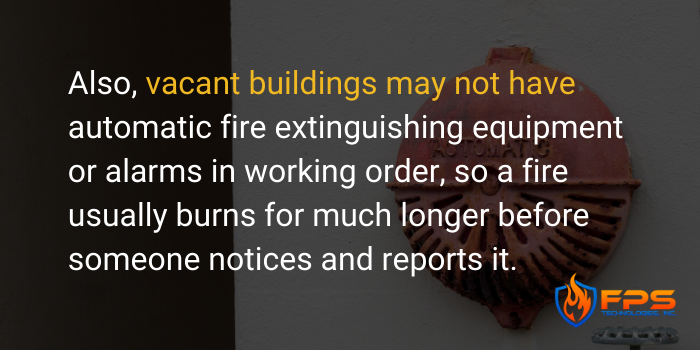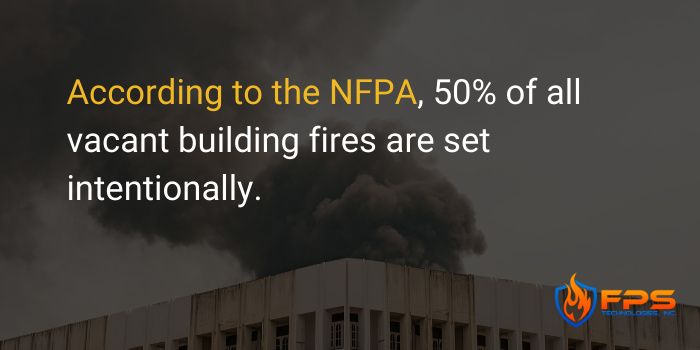During an economic downturn, the number of vacant buildings tends to rise. Whether the building is temporarily vacant or will remain so indefinitely, the dangers are still the same. According to the NFPA, firefighters respond to around 30,000 vacant building fires each year. So, what puts these buildings at such a high risk for fire, and what can you do to secure your property if it’s temporarily vacant? Read on to find out.
Why are vacant buildings at risk?
One of the main reasons that vacant buildings are at an increased risk for fires compared to occupied buildings is that, if a fire starts, there’s no one there to put it out while it’s small and contained to a single appliance or area. In a staffed building, often, these small appliance or equipment fires are smothered right away with a fire extinguisher before they have a chance to spread. However, if you left a coffee pot plugged in when you sent your employees home on furlough, there will be no one there to extinguish an electrical fire that originates at that appliance.
Also, vacant buildings may not have automatic fire extinguishing equipment or alarms in working order, so a fire usually burns for much longer before someone notices and reports it. By the time the firefighters reach the scene, the fire has likely grown and spread through much of the building.

Buildings that are temporarily vacant face different risks than those that are permanently vacant. The more combustible materials there are in a building, the quicker a fire will spread. If a building is permanently empty, the owner can remove all of those flammable materials to reduce the chance of a fire or slow the spread of one. However, that’s not logical or even feasible for businesses that are temporarily closed, as many are right now during the COVID-19 crisis. While your office stands empty but waiting to reopen, all of those essential documents, cleaning supplies, and other materials that are great fuel for a fire are still in the building.
How to protect your property while it’s unoccupied
So, how do you protect your building and all of your essential equipment, documents, and materials without having to empty the building completely?
The best thing that you can do is keep your automatic extinguishing equipment in working condition. That means regular inspections from your staff and professionals like FPS technicians.
-6.png?width=700&name=FPS%20Article%20Graphics%20(1)-6.png)
If there are cleaning supplies in the building, consider removing them since they are often flammable and since doing so is not excessively laborious. Alternatively, you can store them in a fireproof storage area, along with the most important paper documents that you have on hand.
Other dangers of a vacant building
Keep in mind that fires are only one risk that vacant buildings face. They’re also susceptible to excessive water damage from leaky sprinklers, plumbing, or natural flooding. If no one is in the building, the water can continue to collect and stagnate.
Also, we’re entering the annual wild weather season, which brings other natural risks such as lightning strikes that can start fires. Again, maintaining your automatic extinguishing system is essential to minimizing what has the potential to be catastrophic damage.
-4.png?width=700&name=FPS%20Article%20Graphics%20(2)-4.png)
Why your vacant building isn’t just a hazard for you
Beyond protecting yourself from expensive losses, you should also do your part to protect your community. 11% of vacant building fires spread to nearby structures. Right now, we can’t afford to cause any unnecessary damage and destruction in our neighborhoods. We’re all struggling to survive this economic uncertainty together, so let’s not make it harder on each other than it has to be.
Go beyond a fire system
Vacant builds are, unfortunately, a magnet for nefarious arsonists. According to the NFPA, 50% of all vacant building fires are set intentionally. Often, these fires result in more damage than accidental or natural fires because the person(s) responsible may set multiple ignition points to cause maximum damage.

Your best line of defense is to protect your building with a robust security system that you can monitor remotely. It should also send automatic alerts to first responders who can find a perpetrator before he or she is able to start a fire successfully. Often though, having a security system in place is enough to deter most delinquents.
Choose a security partner
FPS offers installation, inspection, and maintenance of both fire systems and security systems. Get in touch for a building audit, to move forward with installing a new system, or for inspection and maintenance of your current components. We can meet remotely or in-person to discuss your needs, so reach out today.


